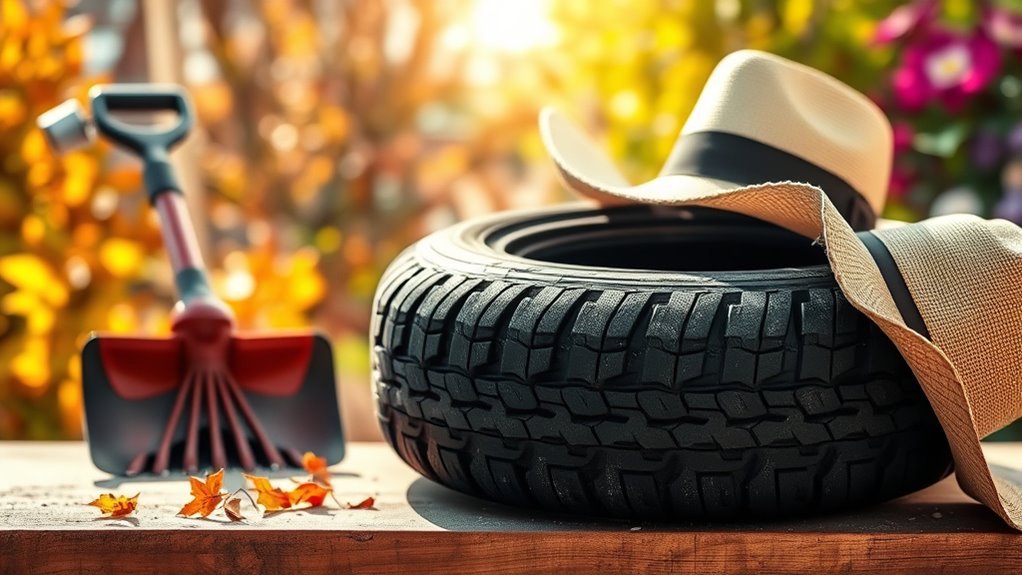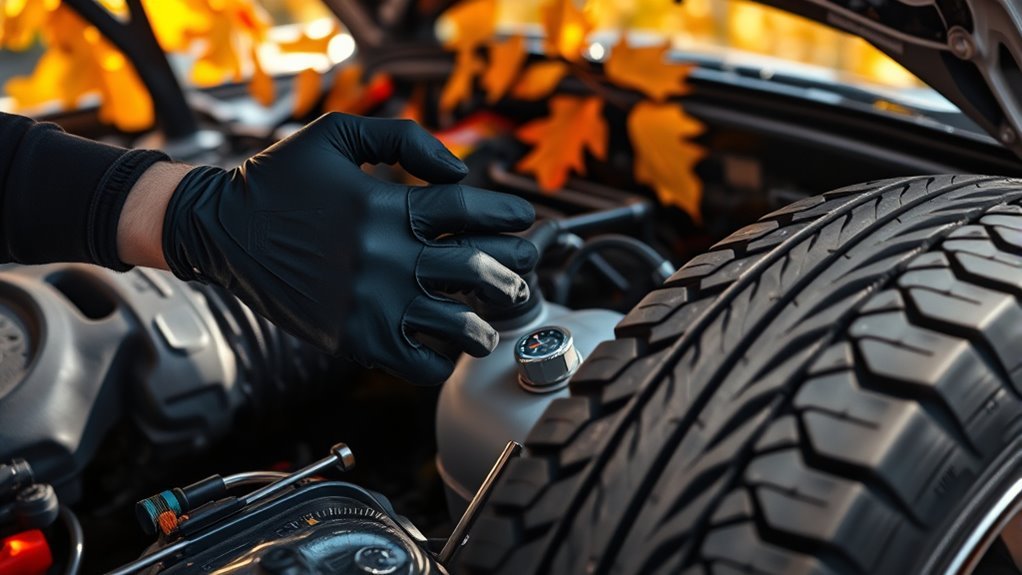Seasonal Maintenance Tips for Car
You should prepare your car each season for peak performance and safety. In winter, install snow tires, check antifreeze, and inspect the battery. Summer calls for A/C and fluid level checks, plus tire pressure monitoring. Spring focuses on cleaning, tire tread, and inspecting belts, while fall emphasizes brake condition and battery voltage. Regularly monitor all fluids for color, viscosity, and contaminants to avoid damage. Following these key steps guarantees reliability year-round—and there’s much more to effective vehicle care ahead.
Preparing Your Car for Winter Weather

Before winter sets in, you’ll want to make certain your car is fully prepared to handle cold temperatures, snow, and icy conditions. Start by installing winter tires, designed with specialized rubber compounds and tread patterns to maintain traction on snow and ice, ensuring safer control. Next, verify antifreeze levels in the cooling system; maintaining the correct mix prevents the engine coolant from freezing, which could cause severe damage. Use a 50/50 antifreeze-to-water ratio unless manufacturer specifications dictate otherwise. Additionally, inspect the battery’s charge and terminals since cold weather reduces battery efficiency. Check windshield wipers and fill washer fluid with a freeze-resistant formula. These precise measures keep your vehicle reliable and free, letting you navigate winter roads confidently without compromising safety or performance.
Essential Summer Maintenance Checks
While summer driving presents different challenges than winter, you’ll still need to perform specific maintenance checks to confirm your car operates effectively in higher temperatures. Start by inspecting your air conditioning system for ideal cooling and check refrigerant levels. Evaluate windshield wipers for wear since summer storms demand clear visibility. Also, monitor tire pressure regularly, as heat causes expansion, affecting grip and fuel economy.
| Component | Maintenance Task |
|---|---|
| Air Conditioning | Check refrigerant, clean filters |
| Windshield Wipers | Inspect blades, replace if cracked |
| Tires | Measure pressure, inspect tread |
| Battery | Test charge, clean terminals |
| Fluids | Check coolant, brake, and oil levels |
These checks confirm your vehicle remains reliable and comfortable during summer journeys.
Spring Cleaning and Inspection Tips

As temperatures rise and winter residues fade, spring is the perfect time to thoroughly clean and inspect your vehicle to verify peak performance. Begin your spring cleaning by eliminating salt, grime, and debris from the undercarriage and wheel wells to prevent corrosion. Use appropriate cleaners on the exterior and interior, making sure all surfaces are spotless. Next, follow a detailed inspection checklist: examine tire tread depth and pressure, check fluid levels—engine oil, coolant, brake, and washer fluid—and assess the condition of belts and hoses for cracks or wear. Inspect brake pads and rotors for residual damage from winter driving. Don’t forget to test all lights and wipers. Completing this rigorous spring cleaning and inspection checklist guarantees your car operates reliably and safely, giving you the freedom to enjoy the open road confidently.
Fall Maintenance to Prevent Cold Weather Issues
As temperatures drop, you’ll want to test your battery’s voltage and inspect fluid levels, including antifreeze and brake fluid, to guarantee peak performance. Check tire tread depth and air pressure, since colder air reduces pressure and affects traction. Additionally, examine brake pads and rotors for wear to maintain stopping power on slippery roads.
Battery and Fluid Checks
Because colder temperatures can greatly reduce your car battery’s efficiency and affect fluid performance, it’s crucial to perform thorough battery and fluid checks in the fall. Start with battery maintenance by inspecting terminals for corrosion and verifying tight connections. Test the battery’s voltage with a multimeter; a healthy battery should read around 12.6 volts when fully charged. If it’s below 12.4 volts, consider replacement to avoid cold-weather failures. Next, conduct a fluid assessment: check engine coolant levels and verify the antifreeze concentration to prevent freezing. Inspect brake fluid for contamination and maintain appropriate levels to guarantee hydraulic efficiency. Also, assess windshield washer fluid, opting for a winter formula to resist freezing. These precise checks secure your vehicle’s reliability, allowing you to embrace cold months without unexpected breakdowns.
Tire and Brake Care
While preparing your vehicle for colder months, paying close attention to tire and brake care is essential to maintain safety and performance. Begin with a thorough tire rotation to guarantee even tread wear, which enhances traction on slick surfaces and prolongs tire life. Check tire pressure regularly, as cold weather causes air contraction, reducing pressure and compromising grip. Next, conduct a detailed brake inspection—examine pads for thickness, rotors for warping, and brake fluid levels for contamination. Cold temperatures can exacerbate existing brake issues, so addressing wear and fluid quality now prevents failure during winter. Proper tire and brake maintenance not only safeguards your freedom to drive confidently but also optimizes your vehicle’s responsiveness when conditions become challenging. This proactive approach keeps you in control and ready for any cold-weather road scenario.
Tire Care Across Different Seasons

Though tires may seem like a simple component of your vehicle, their maintenance varies considerably with seasonal changes. You need to monitor tire pressure closely, as it fluctuates with temperature—dropping in cold weather can reduce traction and increase wear. Tread depth is vital for grip, especially in wet or icy conditions; insufficient depth compromises safety. Adjust your tire choice and upkeep depending on the season to maintain peak performance.
- Check tire pressure monthly and before long trips.
- Inspect tread depth; replace tires below 4/32” for winter.
- Use winter tires in cold climates for enhanced traction.
- Store off-season tires in a cool, dry place away from sunlight.
These steps guarantee freedom on the road regardless of the season.
Fluid Checks and Replacements Throughout the Year
You need to regularly monitor essential fluids like engine oil, coolant, brake fluid, and transmission fluid, as their performance varies with temperature changes. Follow a seasonal fluid replacement schedule to maintain ideal viscosity and prevent component wear. Watch for signs of fluid degradation, such as discoloration, contamination, or unusual odors, which indicate it’s time for a change.
Essential Fluids to Monitor
Because your vehicle relies on several key fluids to operate efficiently and safely, regular monitoring and timely replacement are critical throughout the year. Maintaining ideal coolant levels prevents engine overheating and protects against freezing in cold weather, while evaluating oil quality guarantees proper lubrication and minimizes engine wear. Don’t overlook these essential fluids:
- Transmission fluid: monitors hydraulic pressure and shifts smoothly
- Brake fluid: maintains brake responsiveness and prevents corrosion
- Power steering fluid: guarantees effortless steering control
- Windshield washer fluid: ensures clear visibility in diverse conditions
Seasonal Fluid Replacement Schedule
Four key periods throughout the year demand specific attention to your vehicle’s fluid levels and quality to guarantee peak performance and prevent damage. At the start of spring, inspect and replace engine oil and coolant to prepare for rising temperatures, adhering to manufacturer-recommended replacement intervals. Summer requires checking transmission and brake fluids, as heat accelerates degradation. In autumn, focus on antifreeze and power steering fluids to maintain ideal viscosity during cooler months. Winter demands frequent inspection and possible replacement of windshield washer fluid and battery electrolyte to maintain visibility and electrical efficiency in harsh conditions. Understanding each fluid type’s ideal replacement interval allows you to maintain your car’s freedom on the road without unexpected breakdowns, ensuring a seamless driving experience across all seasons.
Signs of Fluid Degradation
Fluid degradation manifests through distinct physical and chemical changes that signal the need for inspection and replacement. When performing fluid inspection, you’ll want to watch for specific degradation indicators that reveal compromised performance and potential engine damage. These signs help you maintain control over your vehicle’s reliability and prevent costly repairs.
Key degradation indicators include:
- Color shift: Fluids darkening or turning cloudy suggest contamination or oxidation.
- Viscosity change: Thinner or thicker fluids indicate breakdown affecting lubrication.
- Odor alteration: A burnt or sour smell signals overheating or chemical breakdown.
- Presence of particles: Metal shavings or sludge reveal internal wear or contamination.
Frequently Asked Questions
How Often Should I Replace My Car Battery?
You should typically replace your car battery every 3 to 5 years, as the average battery lifespan varies with usage and climate. Pay close attention to replacement signs like slow engine cranking, dim headlights, or dashboard warning lights. Regularly testing your battery’s voltage can help you predict failure before it leaves you stranded. Staying proactive guarantees you maintain your freedom on the road without unexpected interruptions.
What Are Signs My Brakes Need Servicing?
You’ll know your brakes need servicing if you hear persistent brake noises like squealing or grinding when stopping—that indicates worn pads or rotor issues. Also, pay close attention to your dashboard; brake warning lights can signal low brake fluid or system malfunctions. If your pedal feels soft or spongy, or the car pulls to one side, these are precise signs you shouldn’t ignore. Staying on top of these keeps your freedom on the road safe.
Can I Use the Same Type of Oil Year-Round?
You can use the same type of oil year-round only if its oil viscosity suits all seasonal factors you’ll encounter. Oil viscosity affects how well the oil flows at different temperatures—thicker oils work better in heat, thinner oils in cold. Using a multi-grade oil like 5W-30 offers flexibility, adapting to temperature changes without compromising engine protection. Always check your vehicle’s manual to verify the oil matches both your climate and driving freedom.
How Do I Store My Car Long-Term?
Isn’t it ironic that your car, built to roam freely, needs meticulous care when parked long-term? For proper car storage, guarantee a clean, dry environment, top off fluids, and use a quality fuel stabilizer. Disconnect the battery to prevent drain, inflate tires to the correct pressure, and cover the car with a breathable, fitted cover. These precise steps in long term care protect your vehicle’s freedom to hit the road when you’re ready.
When Should I Check My Car’S Alignment?
You should check your car’s alignment whenever you notice alignment signs like uneven tire wear, your vehicle pulling to one side, or a crooked steering wheel while driving straight. Also, after hitting a curb or pothole, it’s wise to get alignment adjustments done promptly to avoid further suspension damage. Regular alignment checks every 12,000 miles or annually help maintain precise handling, ensuring your freedom on the road isn’t compromised by poor steering response.





